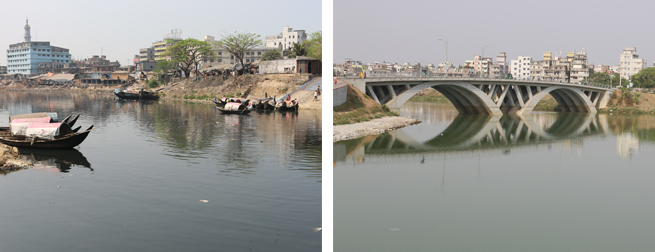Dhaka River Basin (Bangladesh)
Water users/ Stakeholders
Dhaka Water Supply & Sewerage Authority (DWASA):
DWASA’s activities have been reorganized by Dhaka WASA Act, 1996 and according to this act, DWASA it is operating as a service oriented commercial organization. Now, the jurisdiction of Dhaka WASA is more than 360 Sq. km and the population is about 125 million. For better operation, maintenance and customer care, the total service area of DWASA is divided into 11 geographic zones, which includes 10 in Dhaka City and 1 in Narayanganj. There is an office for each zone and this office carries out the responsibilities of engineering operation as well as revenue activities. So that respected consumers can obtain all possible services and counseling from one place.

Bangladesh Water Development Bord (BWDB):
BWDB was created under the Bangladesh Water and Power Development Boards Order 1972 (P.O. No. 59 of 1972) as a fully autonomous organization. The reform program and structural adjustment process were undertaken by the GoB for transformation of BWDB is the enactment of the BWDB Act, 2000 that requires the BWDB's functions be guided by the National Water Policy (NWPo)-1999 and National water Management Plan (NWMP)-2004. Policy making and overseeing the overall management of BWDB is now vested on the Governing Council (GC) with thirteen Members headed by the Minister, Ministry of water Resources.
Both are the prime organization for water management of the basin and there is also plenty of others government and nongovernment organization working for the water management.
References and further reading:
Kabir, A., Parolin, B. (2012) Planning and Development of Dhaka – A story of 400 years, University of new south wales, Kensington, NSW 2052, Australia.
Community report, Zila: Dhaka, June 2012, Population and housing census 2011, Bangladesh bureau of statistics Statistics and informatics division, Ministry of planning, Government of the people’s republic of Bangladesh.
Community report, Zila: Gazipur, June 2012, Population and housing census 2011, Bangladesh bureau of statistics Statistics and informatics division, Ministry of planning, Government of the people’s republic of Bangladesh.
Community report, Zila: Narayanganj, June 2012, Population and housing census 2011, Bangladesh bureau of statistics Statistics and informatics division, Ministry of planning, Government of the people’s republic of Bangladesh.
DWASA (2012) Management information system (MIS) report, http://www.dwasa.org.bd/
Hoque, M. A. (2004) Hydrostratigraphy and aquifer piezometry of Dhaka City, Postgraduate Thesis, Institute of Water and Flood Management, BUET, Dhaka, Bangladesh, 37 pp.
Hossain, F. et. al. (2013) Water Resources Vulnerability in the Context of Rapid Urbanization of Dhaka City (a South Asian Megacity), Elsevier Inc., USA.
Majumder, J. R. (2011) A snapshot of socio-economic development of Bangladesh Looking from multiple perspectives.
Rahman, M. A. et al. (2013) Hydrogeological analysis of the upper Dupi Tila Aquifer, towards the implementation of a managed aquifer-recharge project in Dhaka City, Bangladesh, Hydrogeology Journal 21: 1071–1089, Springer-Verlag Berlin Heidelberg, Germany.
Rahman, S., Hossain, F. (2008) Spatial assessment of water quality in peripheral rivers of Dhaka City for optimal re-location of water intake point. Water Resour Manag, 22: 377–391.
Statistical Year Book of Bangladesh (2010) Bangladesh bureau of statistics Statistics and informatics division, Ministry of planning, Government of the people’s republic of Bangladesh.

